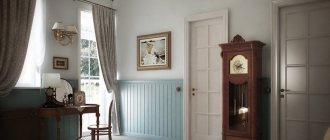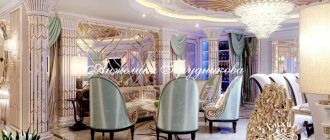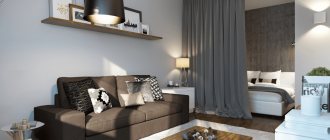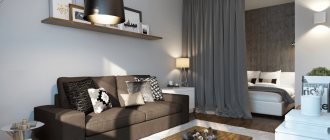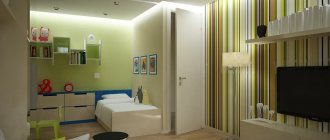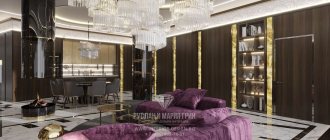Texterra 03/01/2017 Text: S.K.
You've probably seen such granny flats many times, which are usually found in houses from the 30s to the 50s of the 20th century. They are always cozy, comfortable and feel the spirit of the times. Even the hours themselves pass slower in such apartments; everything in them is calm and balanced. The secret of the charm of such interiors from the past is due to the fact that they all have features of the Stalinist style. What makes this style direction so attractive? Why, even many years later, does the Stalinist Empire style not lose its relevance? How can this style be useful when creating the interior of an apartment?
How to choose for different rooms
Empire furniture requires a spacious room; with modest dimensions, it is advisable to decorate the house in a different style.
For the living room, where you plan to receive guests, it is very important to maintain splendor; this can be achieved thanks to massive furniture with luxurious decor, finishing that emphasizes pomp and idleness. In the 19th century, beauty was a priority, so you can see that imperial-style furniture is distinguished by ornate decor and regular lines
In the process of choosing furniture (it doesn’t matter whether the living room or other rooms are being decorated), you need to pay attention to its appearance: it should look as if it was intended for the emperor
When choosing furniture for an empire style interior, it is important to know what features it should have. Bedroom wardrobes must be made of expensive wood and be impressive in size (the minimum width is 130 cm)
Often mirrors are built into cabinets, and their design also includes beautiful curly handles. Beds are usually massive, and their headboards are attractive with their carvings or upholstery.
Often in bedrooms the bed is covered with a canopy (it must be made of the same material as the upholstery of the head of the bed), and ottomans are also placed in the room. Mirrors and a crystal chandelier can hardly be called furniture, but these are decorative elements that play an important role in creating an Empire style. Dressing tables also look very elegant in women's bedrooms.
Do not forget about the decorative elements that emphasize the luxury of the decoration: elegant porcelain dishes, ancient Roman figurines, paintings in gilded frames, mirrors in bronze frames. All this should be in a visible place in the living room.
How many floors are there in a Stalin building?
Nowadays people mostly want to live in nomenklatura houses, directors' houses and private houses. They have no more than 12 floors (most often from six to ten), with two to four apartments on the landing.
You can buy an apartment in the Stalin skyscraper. These are seven (according to plans there should have been nine) high-rise buildings built in Moscow from 1947 to 1957. Residential buildings of these seven: a house on Kotelnicheskaya embankment (32 floors) and a house on Kudrinskaya embankment (24 floors).
Stalin's high-rise building on Kotelnicheskaya embankment in Moscow
House on Kudrinskaya Square in Moscow
Stalin's high-rise buildings in which people live are not only in Moscow. You can look for an apartment in a residential building on Khreshchatyk Street, building 25 in Kiev (15 floors), in Voronezh - Koltsovskaya Street, building 82 (five floors and a ten-story tower), in Kharkov - “House with a Spire” in Armenian Lane, ⅓ ( 11 floors).
House on Khreshchatyk in Kyiv
Stalin's high-rise building in Voronezh
Stalin's skyscraper in Kharkov - the famous “House with a Spire”
Interesting : the service life of pre-war Stalin buildings is 125 years, that is, they should be demolished in 2050-2070. The service life of Stalin buildings of the post-war period is 150 years, they will be demolished in 2095-2105.
Imperial decor: richness and sophistication
No less important element than furniture and decoration is decor. It is this that gives the interior a finished and holistic look. Decorative elements should also correspond to the imperial style and be luxurious and splendid. It can be:
- marble, silver or gilded boxes and candlesticks;
- mirrors in massive bronze or gilded frames;
- fine porcelain tableware;
- watches made of wood or bronze;
- paintings in gilded frames;
- vases made of expensive materials;
- antique figurines.
The paintings may depict battle scenes or important historical events. Massive crystal chandeliers and sconces with bronze candelabra and imitation candles are ideal lamps for Empire style interiors.
Empire style in the living room interior
The windows in such rooms are decorated with forged cornices, curtains made of light fabrics and multi-layered heavy curtains with draperies, wide folds, lambrequins, tassels and fringe. The current color is purple curtains with gold trim, which matches the imperial shades.
The solemnity and pomp of the Empire style make it appropriate in interiors that should look respectable: residences of politicians, offices of bank management and reputable companies, luxury hotels.
Interior design in Empire style - video
+ Similar styles:
- › Baroque style in the interior
- › Interior in Versailles style
- › Rococo in the interior
- › Renaissance style in the interior
voice
Article rating
Decor
In the picture: A plaster rosette and an antique luxurious chandelier are invariable elements of the decor of apartments in the Stalinist style
Interiors in the Stalin Empire style use such decorative elements as: famous Stalin porcelain, clocks, plaster and copper figurines, candlesticks, paintings with classic Soviet subjects, textiles (tablecloths and napkins), lamps, bedside tables or chests, silverware and dishes, vases The Stalinist style decor goes well with classic, modern and eclectic interiors.
Categories: Blog From loft to neoclassicism: 2022 fashion trends in living room design updated: February 9, 2022 by: Olga Kondratova Design Studio
Features of the color palette
The colors of the interiors of the first half of the 20th century are very modest, practically devoid of bright colors. The furniture chosen is predominantly dark, the walls are pastel shades, the carpets are red-brown, the doors between rooms are white, with multi-colored glazing.
The most suitable color combinations:
- linen with mahogany;
- agate gray with terracotta;
- marsh with woody orange;
- antique azure with beige-red;
- lavender with dark brass;
- pale gold with chocolate brown;
- bluish-green with beaver;
- protective blue with light chestnut;
- mustard with iron gray;
- emerald with brick;
- brown-orange with khaki;
- coral with cream;
- creamy yellow with violet-black;
- dandelion with opal green;
- ocher with silver-pink.
Even a monochrome interior allows for bright color accents - curtains, pillows, carpets, paintings on the walls.
Color scheme in the interior
The Empire style loves to combine pastel colors with gold. For a contrasting interior, it is permissible to use several saturated shades.
Blue color in the office will help you feel more confidentSource rehouz.info
Let's consider the psychological impact of color on a person:
- Gold is a symbol of authority, prosperity, and material wealth. The main color when decorating an Empire style room. The golden hue develops logic, increases self-esteem, and contributes to the conclusion of successful contracts and profitable deals.
- White - symbolizes peace, purity, honesty. White visually enlarges the space, fills the room with freshness and perfection.
- Silver helps to concentrate and restores strength.
- Brown - the color evokes a feeling of security, gives confidence, and is able to smooth out a conflict situation. Symbolizes reliability and stability.
- Red, burgundy, wine, terracotta - saturates with powerful energy, charges with optimism, encourages action.
- Blue, light blue - cool tones fill the room with airiness and lightness, treat headaches and insomnia. Blue dulls the nervous system, reduces excitability, develops discipline and organizational skills. Blue promotes speech development and abstract thinking.
- Purple is a symbol of creativity and inspiration. Develops intuition, helps make plans, implement ideas.
- Beige - gives tenderness, romanticism, sympathy, sentimentality. The color has a calming effect, as does the entire pastel palette.
White, gold and brown - looks stylish in the kitchenSource rehouz.info
When decorating an Empire style room, gold is a must. Saturated shades are used mainly in details: furniture upholstery, curtains, bedspreads, tablecloths, pillowcases, rugs. Pastel colors are suitable for decorating walls, most often milk, ivory, beige, cream, white.
Sometimes the interior is done in red colors; red in this case symbolizes victory and the spirit of battle. Source www.topdom.ru
Stalin's Empire style in architecture
Initially, the new style was reflected in the architecture. The decision on the need to create a new style was formulated at the All-Union meeting of Soviet architects, which took place in 1934. Of course, the Stalinist Empire style had to realize very specific goals: to embody faith in a bright future, the main advanced ideas and the successes and achievements of communism. The ideological component also left its mark on the external manifestations of the Stalinist Empire style in architecture.
All buildings in this style are distinguished by their monumentality and solidity, often according to the principle “the bigger and more monumental, the better.” This was supposed to testify to the unity and strength of the people. To reflect victories in the architecture and achieve a broad era, appropriate symbolism was used: stucco molding in the form of laurel wreaths, lions, symbols of Soviet power, inlaid dates of important events. In addition, the technique of architectural order with ideologically correct sculptures was very widely used: these could be workers, peasants, portraits of people's leaders, athletes, scenes from life emphasizing Soviet ideology (mainly scenes of industrial and agricultural production).
The Stalinist Empire style is often also given such a characteristic as gigantomania. Indeed, almost all buildings in this style are massive, distinguished by large
sizes. One of the most famous examples is the Stalinist high-rise buildings in Moscow, popularly called “seven sisters.” They are often compared to the high-rise buildings of America, but they, of course, do not have such a powerful ideological component. The facades of Moscow buildings are decorated in accordance with all the requirements of the new architectural style: there are sculptural images, mosaics, towers, and classical orders.
It must be said that the Stalinist Empire style has quite characteristic distinctive features, which we will now name:
- Preference for ensemble development of squares and streets (this was especially visible and relevant during the period of urban restoration after the war);
- The design style of the buildings was supposed to combine all the achievements of architecture, sculpture and painting, harmoniously linking them together into a single ensemble;
- We have already mentioned the mandatory use of architectural orders;
- Let’s also not forget about sculptural and bas-relief images with heraldic symbols (for example, laurel wreaths were very popular) and images of peasants and workers engaged in labor;
- The general mood of the style is, of course, optimism;
- Bronze, marble, varnished wood, and stucco are widely used.
Speaking about the Stalinist Empire style in architecture, one cannot fail to mention the metro stations that were built at that time and have quite characteristic distinctive features. There are definitely high ceilings, spaciousness, and numerous decorations - stucco, often with Soviet symbols (hammer and sickle, star, coat of arms). If you are interested in seeing this for yourself, take a ride through the stations of the Sokolnicheskaya metro line in Moscow.
Other buildings in the Stalinist Empire style also look very characteristic and recognizable. For example, it was used in the construction of theaters in Novosibirsk and Chelyabinsk. Another very typical example is the building of Moscow State University. The Ukraina and Leningradskaya hotels are also considered striking examples of style.
Characteristic features of the style
A standard “Stalinka” apartment consists of three to five, less often two or six to seven separate rooms, a kitchen with an area of seven to fifteen square meters, a huge living room, and a spacious hallway. One-room apartments were built extremely rarely, and in three-ruble apartments two rooms were sometimes adjacent. All rooms have ceilings more than three meters high, vertically elongated windows facing one or two sides, and in some places there are bay windows. Typically, such housing is located in the “historical” center of a large city - the view from the windows is appropriate.
Apartment design from the time of Stalin combined individual features of Baroque and Napoleonic Empire, neo-Gothic and Art Deco, classicism and modernity. The thick walls of houses of this era were made of red or white brick and other non-combustible materials, and the buildings themselves had at least two floors, an abundance of stucco, and real columns. The doors here are also quite high, often double-leaf, the walls are decorated with profile cornices, and the wide “front” stairs are decorated with carpet runners.
In another way, “Stalin” buildings were called “full-size apartments” or “full-size in houses of the 50s.” Not only residential buildings, but also theaters, departmental buildings, metro stations, sports facilities, and universities were decorated luxuriously and on a grand scale. City buildings were grouped into entire ensembles; the architects of that time tried to use all the achievements of construction and fine art. The principle “the more the better”, gigantomania and optimism were in effect everywhere.
Finishing materials, textiles, furniture
When choosing materials for the Empire style, preference should be given to natural representatives: rosewood and black wood, mahogany, marble, silver, bronze, gilding, porcelain, crystal.
The strict forms of furniture are enlivened by gilded finishing. Source www.topdom.ru
All furniture in the Empire style should be made of the same type of wood, well polished and massive - this will emphasize the sophistication of the room. Oak, alder, umnini, bokota, grenadil, and sandalwood are suitable for production.
Elements decorating furniture can be not only gold, silver fits perfectly into the imperial style. Source www.topdom.ru
Examples of suitable furniture:
- glass display case for antique dishes, luxury drinks;
- a small “recamier” ottoman with decorative pillows and a curved back;
- sofas, armchairs with carved elements;
- pillows embroidered with gold or silver threads;
- large cabinets with right angles, symmetrical bronze plates;
- bookcase with trellis;
- an antique chest of drawers on twisted legs in the shape of swans, lion paws, columns, sphinxes;
- round or oval table, with beautiful table settings;
- artificially aged sideboard;
- carved, desktop;
- high back chairs;
- bed with a large, painted, gilded headboard.
Gilding around the perimeter of the bed and its headboard looks good against the background of white walls. Source www.topdom.ru
For the Empire style, curtains made of thick fabric with interesting drapery are suitable. Curtains are decorated with tiebacks, tassels, fringe, frills, and multi-level lambrequins. It is advisable to upholster upholstered furniture with jacquard fabric with floral patterns, symmetrical stripes, and monograms.
A repeating pattern on the wallpaper and upholstery of the sofa creates harmony in the room. Source www.topdom.ru
Finishing materials must correspond to high cost and pomp:
- Elite parquet with a complex pattern and marble mosaic tiles are suitable for the floor.
- The ceiling is almost always painted white or ivory. In the center they decorate with a rosette made of plaster, along the perimeter - with stucco molding with ornaments.
- Fabric drapery is suitable for walls: silk, brocade, velvet. You can use textile wallpaper; the width of seamless patterns reaches 3.5 meters. Aged wooden panels on the walls will look beautiful.
Wallpaper with symmetrical, vertical stripes is suitable for the walls in the dining room. Source www.topdom.ru
Empire style in the interior is an atmosphere of wealth and unquestioning power. In such a room it is easy to feel like the emperor of the world.
For an Empire style bathroom, gold-plated faucets and towel holders are selected Source www.topdom.ru
Features of the Empire style in the interior
Empire style is traditionally used in the interior for the ceremonial decoration of spacious halls, as well as offices, living and dining rooms. It skillfully combines motifs from the majestic ancient civilizations of Egypt, Greece and the Roman Empire, and also contains individual features of strict classicism.
And yet, Empire style is not so difficult to distinguish from other styles by its characteristic features, including:
- Centric (radial) composition of the room space.
- Rich carved ornaments of furniture made from valuable wood.
- An abundance of heavy window drapery using dense expensive fabrics.
- A large variety of decorative items made of bronze and silver.
- Decorate the walls with large paintings on historical themes and mirrors in expensive carved frames.
- Decorating walls and ceilings with stucco or ornaments with ornate patterns.
- The presence of monumental columns and pilasters in the interior design.
Whether the interior belongs to the Empire style can also be easily determined by the presence of a large number of military paraphernalia in the design of the room:
- shields;
- armor;
- cold steel and firearms.
An important role in the interior is played by three-dimensional works of fine art - sculptures and busts made of bronze or natural stone. The main source of light in the room at night is usually a massive chandelier. In addition to it, metal floor lamps, wall sconces and table candelabra are used for lighting.
The color palette of the rooms is dominated by light and golden shades, which maximally emphasize the triumph of luxury. Red and blue colors perform an auxiliary function - they highlight important secondary details of the situation against the general background.
The ceilings have a straight or domed shape. They are most often painted white and decorated with gold stucco. Skillful paintings on historical, religious or mythological themes are also very popular. The ideal flooring option is considered to be varnished artistic parquet with complex patterns. Less common are floors made from natural marble.
Hotel “Leningradskaya”
The next high-rise building is located near the square of three stations. It is the smallest of all (136 meters, 17 floors). The Hilton Moscow Leningradskaya Hotel is located here. Reconstruction was carried out in 2008, the building is classified as an architectural monument.
The number of rooms in Leningradskaya after reconstruction decreased to less than 300, their cost is also significantly lower than in Radisson Royal. The cheapest costs 6,500 rubles, the most expensive, presidential suite, “only” 86,500. Let’s see what’s inside:
The interiors are made in the “Russian style”.
Gilding, bas-reliefs, bright colors, expensive stones...
“Leningradskaya” also has an attribute listed in the Guinness Book of Records. This is the longest chandelier in the world, stretching 15.5 meters and 5 floors.
The Russian style continues in other rooms.
And there are some elements of other cultures.
And a little more about the hotel's interior:
What style is this?
Assessments of the past gradually change over time, lose their former emotionality and become more balanced, based on logic and facts. It is becoming increasingly clear, for example, that the 50s were a period of greatest qualitative growth in the USSR and at the same time a period of breakdown. But a significant architectural heritage remains from that era - the so-called Stalinist Empire style.
When visiting such a home, you immediately notice the characteristic coziness, comfort and special flavor. Similar construction was carried out on a large scale in 1930-1955. (which gave the style its name). A typical project included 4 or 5 separate rooms. The kitchen was not very large, and the ceiling height reached 3 or 4 meters. The windows could face either one or two sides at once.
There was a hall and a large living room. Almost always they tried to make high windows and bay windows
An important “passing” component was the location in the best part of the city and the corresponding views from the windows
The interior itself traditionally reveals:
- stucco;
- wide ceiling cornices;
- sockets for chandeliers;
- wooden floors laid out in a herringbone pattern (separately for each room);
- crystal lamps;
- square and rhombic glass layout;
- high white interior doors with wood carvings (glazing is available both fully and partially);
- dark furniture imitating oak or dark walnut;
- Grandfather Clock;
- round dining tables;
- offices with leather sofas and a characteristic green lamp on the table;
- crystal vases;
- fine tableware;
- silver plate;
- an abundance of paintings and books;
- traditional red carpets.
Not all of these attributes are necessarily present today. However, the abundance of decor and the focus on maximum beauty and comfort remain unchanged.
This approach is invariably popular and attractive, despite all the latest design delights. The time has come, however, to find out what causes this, what else you need to know to arrange your home in the appropriate spirit.
History of style
This style originated in the USSR in the mid-30s of the 20th century. Initially, the Empire style was a pompous, majestic architectural style that arose in France during the time of Napoleon the First. In the 30s of the twentieth century, such luxurious, monumental buildings began to be built in the Soviet Union, when J.V. Stalin began to rule the country. In the 50s, such architecture began to be sharply criticized, considering it an excess that was unacceptable for a Soviet person, and after Stalin’s death, all the projects started were sharply simplified, eliminating decor as much as possible, and in some places sharply reducing the total area and ceiling heights. Multi-room apartments were mostly given over to “communal apartments”, in which several families lived at the same time, using a common kitchen and bathroom.
Room design examples
The total area of a Stalinist two-room apartment is about 30 meters, a four-room apartment is about 60 meters, a seven-room apartment is up to 160 square meters. The more rooms there were, the more spacious each of them became.
What kind of premises were there:
- kitchen;
- one or more bedrooms;
- cabinet;
- living room;
- bath or shower;
- restroom;
- hall;
- pantry.
There were no dressing rooms in those days - clothes were stored in built-in closets and storage rooms. For children's bedrooms, special furniture, with the exception of a crib, did not exist at all - for these purposes, the smallest rooms were chosen, where they placed a crib, a simple cabinet, a table with a chair, a box with toys, and a bookshelf.
Living room
The area of the Stalinist living room is from 16 to 30 square meters. The ceilings and partly the walls are richly decorated with stucco, in the middle there is a multi-tiered crystal chandelier. Along one of the walls there is a wall cabinet, in which there are always many thick books with neat “spines”, and in the glazed sections there are beautiful ceramic dishes, a tea set for six to twelve people, and many porcelain figurines.
The main decoration of the living room is the TV; it is placed on a stand with four cone legs or a wall console decorated with stucco. In the center of one of the walls there is a floor or hanging clock with a chime, richly decorated with carvings; on several others there are paintings in the spirit of rough “Soviet realism”, decorated with heavy frames. Without fail, there is a sofa covered with luxurious drapery, complemented by a pair of armchairs and a carved dressing table. All furniture elements are united by a patterned carpet that occupies most of the room. Photo wallpapers depicting a mid-twentieth century cityscape are also acceptable.
Kitchen
The kitchen of the Stalinist Empire style has an area of 7 to 15 meters. There is usually no kitchen set as such, there is only a not very spacious sideboard with dishes, table linen, and a low round refrigerator. The worktop is made of natural stone or oak; underneath there are drawers, sections for silverware, and various kitchen utensils. A few household appliances are placed on any horizontal surfaces. The dining area is decorated with a dining table covered with a fringed tablecloth; chairs are also draped with removable covers. Crystal fruit bowls, potted foliage plants, and heavy metal candelabra are placed in prominent places.
Bedroom
The average area of any bedroom is about nine meters. A single or double bed is located in the center of one of the walls, the headboard is decorated with stucco moldings, next to it there are one or two bedside tables or a carved dressing table with a valance in the color of the curtains. The shelves above the bed are decorated with black and white photographs in wooden frames and small figurines made of copper or bronze. There is also a small glossy two-door wardrobe, which at that time was locked with a key, or less often - a forged chest for storing linen and various “belongings”. Beige-brown wallpaper with stripes or floral patterns will complement the chosen style. Be sure to lay a carpet on the floor; if desired, it can be supplemented with a wall carpet.
Office-library
It was believed that everyone in the USSR read, so every family had a lot of books. A study with a desk was usually combined with a library, which consisted of solid wood shelves up to the ceiling. Sometimes they hid the surfaces of all the walls, and in order to get the desired book from the top shelf, you had to use a stepladder or a special wooden stand with two or three steps, because the ceiling height was often about four meters.
In the modern version, there may be a little less books, and the desk is replaced by a computer. On open shelves there are plaster or bronze figurines, stylized for that era. A map of the Soviet Union, a red flag or an image of the coat of arms is hung on the wall.
Hallway
This room is decorated no less luxuriously than all the others. There is herringbone parquet or real marble on the floor, dark patterned wallpaper combined with wooden panels on the walls, stucco molding and a ball lamp on the ceiling. From furniture, a carved trellis, a wooden wall or metal floor hanger, a small couch combined with a shelf for installing a home telephone are appropriate here. The carpet will also fit in with the theme.
Elements of Stalinist decor, accessories
The decorative elements of the Stalinist Empire style are very original - five-pointed stars, a hammer and sickle, images of ears of wheat tied with a ribbon, laurel wreaths. These are voluminous plaster or carved panels depicting ordinary working people, enthusiastically working for the benefit of a great country. On shelves, tables, and other prominent places there are bronze, wooden, porcelain figurines or sculptural groups of ideological orientation. There are also bas-reliefs with lions, as well as inlays with paintings of socially significant events.
Furniture selection
The furniture chosen is luxurious, high-quality, massive, mainly made of natural wood (oak, walnut, rosewood) and metal. It is often varnished and decorated with 3D carvings and mosaics. These are cabinets with carved “crowns”, convex sideboards, round or oval dining tables, leather chairs and sofas with high backs, heavy wooden chairs with turned legs, beds with balls or peaks in the corners. Wood carving is welcome here both in the form of complex plot bas-reliefs and simple “geometric” designs. Overlay slotted elements made of valuable wood are acceptable. In addition to natural or artificial leather, various fabrics are used as upholstery material - plain or with floral patterns.
It's all about the color
Empire style is, first of all, luxury. Therefore, colors in this style need rich, bright, but at the same time calm and proud. Classic of the genre - gold. This is a symbol of power and wealth, so you can feel free to use gold trim as decoration.
As base colors in the Empire style, it is best to choose noble, rich colors: blood red, deep blue, sky blue or white. However, you should use color combinations carefully. To avoid getting avant-garde instead of the Empire style, you need to keep the premises in a certain color scheme, avoiding tricolors. The walls, floor and ceiling should be in harmony with each other.
Features of the Empire style in the interior
In the Empire style, walls play an important role. They occupy the lion's share of the room's space and attract attention even at the entrance. Therefore, silk or brocade fabrics are most often used as wall decoration.
Empire style in the interior
Empire style design idea
Walls
Considering the progress achieved in modern interiors, expensive fabrics can be replaced with textured coatings that imitate woven materials. Wallpaper decorated with African motifs or military-themed symbols will look best. If you need to create a more formal atmosphere, you can use textured wall coverings with a simple, monosyllabic pattern.
Also, the walls, when decorating rooms in the Empire style, are usually decorated with blind arcades, Roman columns, medallions, frescoes and bas-reliefs. Artistic decorative elements decorating the walls must certainly intersect with military themes. Large mirrors are a must.
Empire style in the interior of the room
Empire style room design
Modern apartment design in Empire style
Ceiling
The ceiling is no less important. To design it, you also need to use only natural and expensive elements. A large crystal chandelier should be placed strictly in the center. Around the main part, the ceiling is decorated with gilded stucco. The color is most often white, but you can take liberties and use milky or light beige materials for painting.
Floor
If we are talking about the Empire style, then the choice of floor coverings is not very large. You can use either mahogany parquet or marble mosaics, with motifs from Greek or Roman artwork.
Window
Windows, depending on the purpose of the room, can be decorated with silk curtains or multi-layered heavy fabrics with fringes. The color palette of the curtains should be in the style of imperial palaces - purple, red base with gold embossing and edging.
Empire style in the interior
Empire style design idea
Furniture
Empire style furniture is heavy objects made of mahogany, decorated with carvings and gilding. The surface of furniture in an Empire style interior is always smoothly polished, the legs are most often made like lion paws, Egyptian sphinxes or Roman columns. When choosing furniture for a modern living room, it is best to give preference to antique samples.
Rooms decorated in an imperial style will be perfectly complemented by antique chests of drawers, sideboards, round tables, and elegant couches with soft shapes. By the way, the Empire style acquired smooth features after adaptation to the Russian public. The French, called upon by the nobility, decorated the estates of the nobles, softening the military-triumphal forms of the French style.
Empire style in the interior of the room
Empire style room design
Modern apartment design in Empire style
Features of planning, design and placement
Stalinist houses usually have high ceilings - three meters, sometimes higher. The areas are also quite large: from fifty to one hundred sq.m. The kitchen can be 15 sq.m (this is in seven-room apartments). The windows are also high - two meters. The width of each door is 750 meters.
Windows in a Stalinist house - two meters, balcony windows - 2,700 meters
The walls were built of bricks. Before the war - from red, after the war - from white. The building materials were of high quality, so the steel buildings are still in good condition.
Houses built by Stalin on Gagarin Square (No. 30 and No. 37a)
The layout is convenient: all rooms are isolated, there are no passage rooms. Sound insulation is very good. Bathrooms are separate.
Layout of a Stalinist apartment
Usually there are three or four rooms in a Stalin building. Less often - two, and very rarely - one.
Total area of steel buildings:
— one-room apartment — 32-50 sq.m;
— two-room — 44-70 sq.m;
— three-room apartment — 57-85 sq.m;
— four-room apartment — 80-110 sq.m.
Read also : Symphony of white walls with wood: apartment for a family with four children.
What stucco looks like in Stalinist houses of the pre-war period
Interesting: when the Stalinist buildings were built, there was no gas supply in the cities (natural gas appeared in Moscow only in 1946). Food was cooked on wood-burning stoves, which is why Stalinist houses had powerful chimneys.
Simplified stucco molding in post-war Stalinist style
The thickness of the external walls is 2.5 bricks (65 cm), and the internal load-bearing walls are 1-1.5 bricks (25-38 cm). The internal partitions are made of wooden planks, covered with a mesh of shingles and plastered. In later Stalinist buildings, plasterboard partitions were made.
The two- or multi-pitched roof forms a large attic; it was covered with slate or roofing iron.
Main features of the Stalinist style
In the photo: Kitchen design in the Stalin Empire style
The Stalinist style was originally inherent in apartments in houses built during the time of Stalin. This type of housing is characterized by a certain location and layout. A classic apartment from the 30s to the 50s has 4-5 separate rooms, a small kitchen, high ceilings (3-4 meters), windows on one or two sides, a hall and a large living room. As a rule, housing in Stalinist houses has high windows and even bay windows. An apartment of this type is, of course, located in the city center and has appropriate panoramas from the windows. As for the design of apartments in the Stalinist style, they must have stucco molding, wide ceiling cornices, sockets for chandeliers, and herringbone floors. By the way, the floors are not installed uniformly throughout the entire apartment, but separately in each room. At the same time, they are separated by the same herringbone boards, laid as a border.
Apartments in the Stalinist style usually have:
- crystal chandeliers and sconces;
- tall white interior doors with carved trim in a classic style, with full or partial glazing;
- glass layouts in a square or diamond shape;
- in contrast with light doors and walls - dark, free-standing furniture in dark walnut or oak, cabinets, sideboards, bookcases and sideboards with carved “crowns” and glass doors, tall grandfather clocks, a large round dining table, armchairs, sofas and chairs , dressing and coffee tables on carved “paws”;
- white tablecloths, beautiful dishes, crystal vases, jugs and salad bowls, silverware, curtains with tiebacks;
- a “professor’s” office-library with a leather sofa and a lamp with a green lampshade;
- a large number of books and paintings;
- red carpets.
In the photo: Living room interior in the Stalin Empire style
A Stalinist apartment is always cozy, it has a lot of textiles and decor. Often found porcelain figurines, candlesticks, vases, black and white photographs, paintings and even beautifully arranged dishes in the buffet - all these are features inherent specifically in the Stalinist style. The attributes of this style trend are everything that is currently antique. There is something from the classics, something from the Empire and Baroque, such an interior is easy to complement
An interior in the Stalinist style will never go out of fashion and will not lose its relevance because the comfort, coziness and continuity that can be read in all its details always attract attention. The Stalinist apartment serves as a real home for its inhabitants; it is pleasant to return to it every evening
Bedrooms and children's rooms
In the photo: Bedroom interior design with elements of the Stalinist Empire style
In Stalin's times, the walls in bedrooms were usually decorated with wallpaper, which was not always light. Most often, preference was given to wallpaper in brown, burgundy or coffee colors. The design could contain a stripe or other not very bright ornament. If you want to preserve the style of the 30s-50s in your home, use this kind of wallpaper. The furniture set in the bedrooms was usually standard and included: a bed, a pair of bedside tables with reading lamps, a trellis that served as a dressing table, a wardrobe (namely a closet, not a dressing room), and a chest of drawers. Bookcases in rooms designed in the Stalinist Empire style were not usually used for sleeping. Books could be kept in the living room, office, library, nursery, but not in the bedroom.
In apartments of the Stalin period one could often find storage rooms, built-in wardrobes, dressing rooms, walk-through rooms, even personal entrances to the bathroom from the bedroom, but not dressing rooms. The furniture was usually from one set. But the decoration of children's rooms was not given such close attention as the decor of bedrooms. Furniture in children's rooms in Stalin's times was modern, domestically produced. The children's rooms themselves were small, and not very well furnished. A small work table, narrow beds, small wardrobes - this is a typical set for a child's room of that time. In recent years, attitudes towards children have changed for the better. Therefore, in apartments in the Stalin Empire style, they now try to furnish rooms for children with no less care than bedrooms.
Stalin's Empire style in the interior
The Stalinist Empire style is not only the external design of buildings. It is also reflected in the interior. And now, by the way, this style continues to be popular, probably due to its main ideological components - optimism, good quality and reliability. But, of course, without elevating the ideology of communism and its achievements to a cult.
Needless to say, living in a Stalinist house in Soviet times was considered very prestigious. Because there were really good apartments there: with high ceilings, good layouts (they had 4-5 spacious rooms!). Such apartments were characterized by high windows designed in the form of a bay window.
If we talk about interior design in the Stalinist Empire style, then this is the presence of stucco on the ceiling, laying out parquet in a herringbone pattern, each room can have its own type of parquet, sockets for chandeliers. Carpets are placed on the floor, preferably red ones.
When choosing details for interior decoration, you should pay attention to luxurious crystal chandeliers and sconces. It is better to choose furniture from dark wood, walnut or oak, lacquered
The Stalinist Empire style in the interior includes tall bookcases with glass doors, sideboards filled with beautifully arranged crystal and porcelain dishes, and buffets. You can add the characteristic atmosphere of that time to the interior by installing a large grandfather clock made of dark wood, a round dining table with massive chairs. Coffee tables were also widely used, of course, not made of glass and iron, as in our time, but wooden ones with carved legs.
As opposed to dark furniture, it is better to choose light pastel colors for the walls.
White interior doors with mandatory glazing are widely used in Stalinist Empire interiors. Moreover, the glazing can be in the form of a mosaic.
To create coziness, details such as beautiful white tablecloths, massive curtains with holders, bronze figurines and candlesticks, and crystal vases are actively used. The dishes must be of high quality, made of light porcelain. If you have silverware, feel free to use it too, this is also a detail for creating style.
The walls are decorated with paintings. It would be good if there was a separate corner for a library - with solid wood cabinets filled with books. You can make an office in the style of that time: a massive table, a dark leather sofa and a lamp with a characteristic green lampshade.
In a word, the Stalinist Empire style in the interior is a very pleasant style, one might say, timeless, because it is aimed at creating a feeling of good quality, faith in the good. And it is there that you can use things left over from elderly relatives so that they become not unnecessary junk, but real antiques.
artishock.org
Antique furniture
In the photo: Antique furniture is often used in Stalin-style interiors
Antique furniture looks great in any interior. And furniture from the Stalin era is almost universal. An antique sideboard made of dark wood will well complement the design of a bright kitchen-living room, even made in a modern style. A bookcase from the times of Stalin will add zest to the office. The interior, which contains antique furniture, looks interesting and memorable. Antiques make a space more personal. But be careful when filling your interior with antique furniture. After all, if you overdo it with antique items, you can simply clutter the space. This can happen if you use too many small pieces of furniture. After purchasing a new antique table, replace it with a modern shelf by the bed. Furniture can “move” around the apartment and change its purpose. Don't be afraid to rearrange the furniture, this way you can easily change the interior. Plan the arrangement of large antique items, such as a sideboard, buffet or bookcase, in advance. During the Soviet period, “professorial” apartments were furnished with pre-revolutionary furniture sets, which smoothly transitioned into the style of that time.
Lighting
The main lighting fixture of this era is a luxurious crystal chandelier located in the middle of the ceiling. Later, similar structures were made of plastic, which significantly affected the appearance and durability of the device. Individual areas were illuminated by floor lamps, often with textile shades decorated with floral patterns and fringe. Wall sconces, usually styled as torches, were mounted on bronze figured brackets above the kitchen table and bed. The workplace was illuminated by a table lamp with a greenish shade on a flexible base. In the children's room, in addition to the main light, there were small night lights, plugged into an outlet, decorated with stone or plastic. In modern times, the design is complemented by LED lighting, which, with the right approach, will not at all disrupt the basic style.
